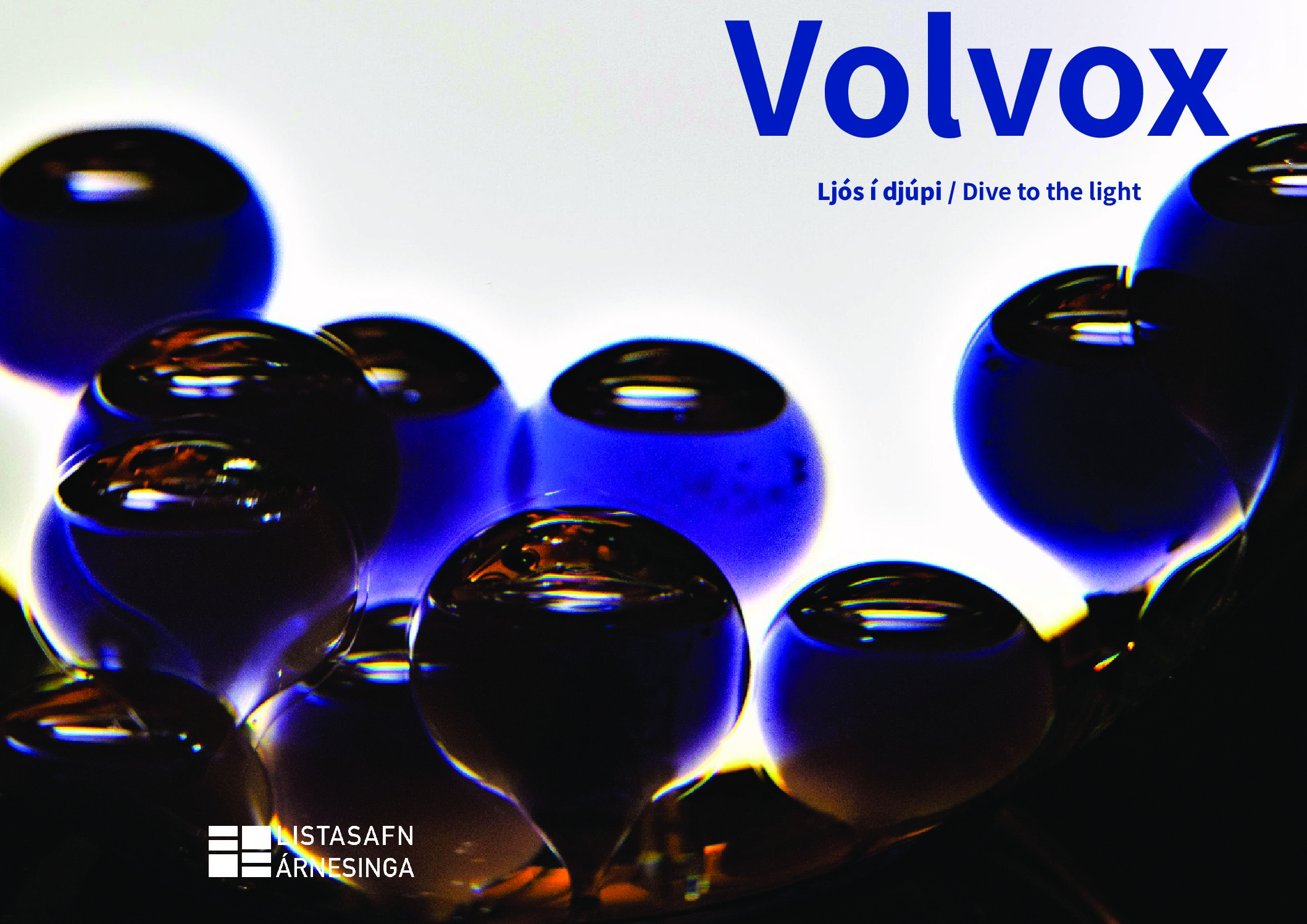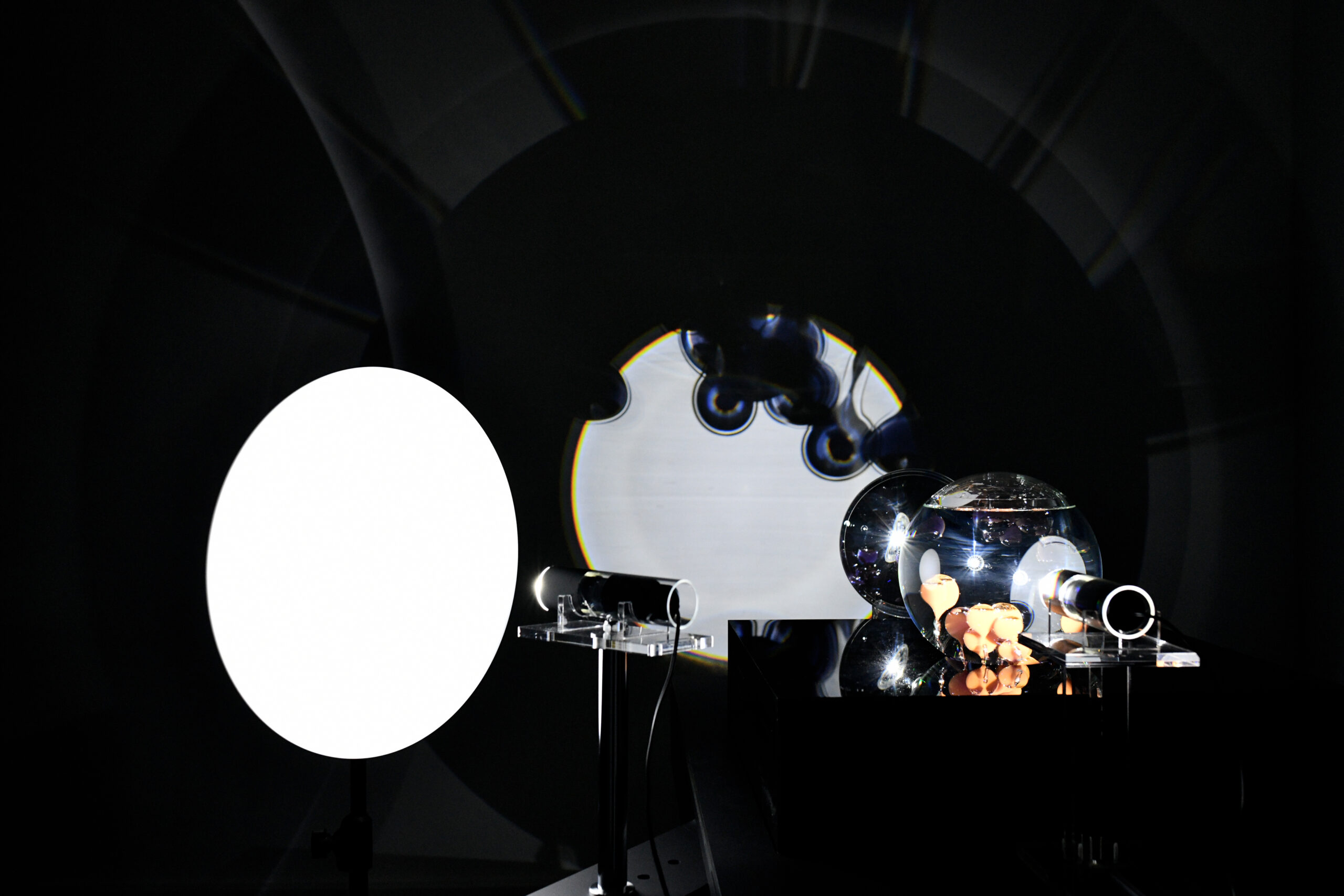
Volvox
Dive to the light
Gallery 4
September 14th – December 22nd 2024
Thomasine Giesecke, visual artist / Jean-Marc Chomaz, physicist artist @LadhyX, Ecole Polytechnique / Bruno Palpant physicist @LuMIn, Université Paris-Saclay / Tom Georgel, sound artist, in collaboration with Hynd Remita and Mireille Benoit, chemists @Institut de Chimie Physique, Université Paris-Saclay / Jean-Michel Wierniezky, Ecole Polytechnique / Claude Beghin, Maïa Menuiserie / Colin Lopez LuMIn, Université Paris-Saclay /
The result of a collaboration between artists and scientists from the Hydrodynamics Laboratory of the Ecole Polytechnique (LadHyX, Institut Polytechnique de Paris), the Light, Matter and Interfaces laboratory (LuMIn, Université Paris-Saclay), and the Physical Chemistry Institute (ICP, Université Paris-Saclay) the Volvox project is inspired by the eponymous microscopic spherical alga. The envelope of this freshwater alga is a biofilm connecting hundreds of independent cells. Spherical daughter colonies develop inside the sphere. To swim towards the light and feed, the movement of all the unicellular’s cells must synchronize, and the Volvox performs a dance alternating coherent movement and random reorientation. For the life sciences, Volvox represents a stage in the evolution, a step towards complexity, being a multicellular organism with mechanical and chemical communication between cells.
The Volvox installation is a metaphor for life in which the endless search for light is transposed using gold nanoparticles suspended in water. They fill glass capsules that are themselves caught in a dance that is both random and synchronized within a rotating transparent sphere. By changing the angle of observation in relation to the incidence of light, the public can experience the relativity of the notion of color, as the gold changes from blue to orange, passing through light purple, itself a complementary color to the green of the algae. This dichroism coloring effect is due to the dominant contribution of the localized surface plasmon resonance phenomenon in the nanoparticles, which affects both the absorption and scattering of light.
The sound creation uses the Volvox algae scenario as a musical form. Each Volvox induces musical sounds that envelop the audience, spectators of a series of coordinated movements that give way to the natural process of chaos.
Photographer ©Philippe Henri Doucet
—–
Thomasine GIESECKE is a visual artist and a yoga instructor. Her sculptures and installations are minimal to monumental having worked in fields as eclectic as jewelry making to furniture.. Her favorite subject is “Glass Scatter” which reveals bare sensuality and discrete refinement. She has created monumental sculptures for the headquarters of companies such as Alstom Transport or Bouygues Telecom (Saint-Ouen, Paris). Her research on the medium of glass has led her to establish bridges between science and art collaborating with researchers to create sculptures and installations that offer a window into the intrinsic quality of nature’s details which are invisible to the naked eye.
Since 2006, she has been creating educational programs and workshops for visitors pertaining to the permanent and temporary collections at the Musées d’Orsay, Musée de l’Orangerie, the Louvre and the Eugène Delacroix Museum. She established the association “l’Atelier de Thomasine” in 2009 and organizes sensorial and artistic workshops for children and adults.
She was a guest artist for two residencies at LÁ Art museum in Iceland, and is currently organizing her third visit to present her collaborative pieces: Volvox and Metamorphosis which both reflect on the fascinating subject of “Minerals a living organism”.
http://www.thomasinegiesecke.com/
Jean-Marc CHOMAZ is an artist physicist, director of research at the CNRS, professor co-bearer of La Chaire arts & sciences, École polytechnique, École des Arts-Déco and Carasso Foundation 2017-2023, that gave rise to the Interdisciplinary Center SPIRAL. He co-founded the Hydrodynamics laboratory of CNRS-École polytechnique, the laboratory of excellence Systems and Engineering of Paris Saclay University, and La Diagonale in 2012. Alumnus of the École Normale Supérieure, he has advised 31 PhD in science and in art and co-authored more than 250 publications. He received the CNRS Silver Medal,2007 and the Ampere Grand Prize of the Academy of Sciences 2012. His research concerns the dynamics of soap films, theory of instability, vortex breakdown, geophysical and stratified fluids, biomechanics and arts & sciences. As an artist, he created the installations Un chemin qui chemine, Time traces, Terra Bulla, the series Une solution au problème de raréfaction du Temps – Futur, Bogota 2019, Passé, Anamorphose, Bourges contemporain 2021, Five Black Rivers Paris 2024-, Thousand shades of Green, OU/ERT, 2019, Incipit Temporis, Silmarils, Veridis Sol, Reshift-becoming machine, Instandsetzung#3 2022 and wrote the poem series N56u3N4A published in the review Plastir. He created also more than thirty other installations in collaboration through the collective LABOFACTORY.and with many different international artists.
Bruno PALPANT is a full professor at CentraleSupélec, University Paris-Saclay. He co-founded in 2020 the laboratory “Light, Mattter, and Interfaces” (LuMIn, about 85 people), and has been its deputy director ever since. LuMIn is affiliated to the University Paris-Saclay, the ENS Paris-Saclay, the CNRS, and CentraleSupélec. Bruno Palpant is also associate professor of INRS, Québec, Canada. He carries out research activities dedicated to the study and exploitation of the remarkable optical properties of coinage metal nanoparticles, whose colour effects have been used in decorative arts for several millennia. He and his team are particularly interested in the interaction of these nano-objects with ultrashort laser pulses. Their multidisciplinary projects propose applying the phenomena generated by this interaction to develop new functional materials, as well as photonic and biomedical technologies, including ultrasensitive sensors and new therapies. B. Palpant also teaches this discipline —plasmonics— in several master courses.
Pianist, composer and improviser, Tom GEORGEL works with music in its many aspects. His debut album Et Toc! (2022) proves it by writing with and for improvisers, voices, and a very poetic dramaturgical development. This orchestral work of friction of the elements shows up in Tremblement (2022), Récréation premiered at Paris Philharmonie (2024), and Aladdin (2024) with his own ensemble Camion Rouge.
In Les Jours Ordinaires, commissioned by XXI.n, for actress, flute, accordion, cello and electronics, he explores the music of encounters and social distances. The show is hosted at the Cité de la Voix (Vézelay) and the POTE Festival. Tom Georgel developed the music part of Volvox during a residency at the École Polytechnique with the Chair of Arts and Sciences. He also works in the film music field, especially with Bertrand Hagenmüller : Prendre Soin (2018), Jeunesses d’Autres-Mers (2022) and the soon to come Les Esprits Libres (2025).
Piano player in all directions, he tours with Johan Boutin and their show Miz B & Mr G, a space of freedom and engagement through chansons from the French repertoire. He is part of Marie Mifsud’s quintet in her two albums Là and Récif and accompanies Juliette Meyer and Estelle Meyer. On stage, he composed and accompanied works of Alex Crestey, Philippe Mangenot and Benjamin Groetzinger (The Little Prince).


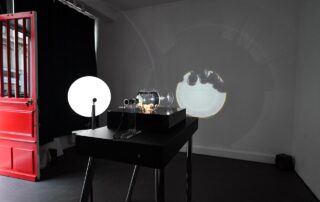
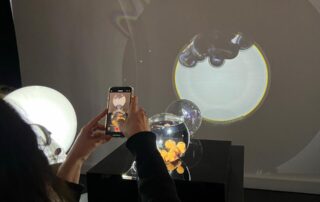
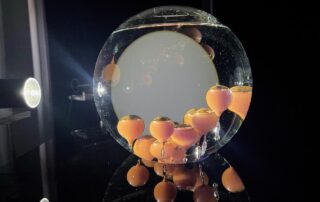
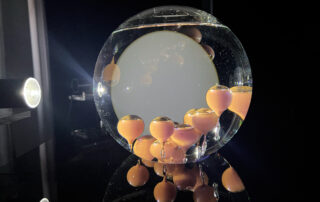
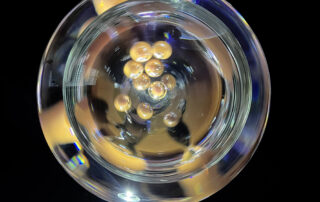
![GS-institute-light-v-229-1945-en[8]](https://listasafnarnesinga.is/wp-content/uploads/2024/03/GS-institute-light-v-229-1945-en8.jpg)
